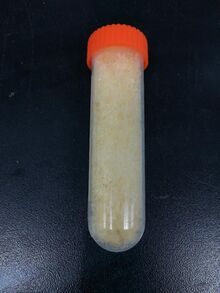Chemistry:Samarium(III) nitrate

| |
| Names | |
|---|---|
Other names
| |
| Identifiers | |
3D model (JSmol)
|
|
| ChemSpider | |
| EC Number |
|
PubChem CID
|
|
| |
| |
| Properties | |
| Sm(NO3)3 | |
| Molar mass | 336.4 g/mol |
| Appearance | Sligtly brown crystals |
| Odor | Odorless |
| Melting point | 78 °C (172 °F; 351 K)[1] |
| Boiling point | 420 °C (788 °F; 693 K)[2] (decomposition) |
| Soluble[1] | |
| Hazards | |
| GHS pictograms |    
|
| GHS Signal word | Danger |
| H272, H315, H318, H319, H335, H410 | |
| P210, P220, P221, P261, P264, P271, P273, P280, P302+352, P304+340, P305+351+338, P310, P312, P321, P332+313, P337+313, P362, P370+378, P391, P403+233, P405, P501 | |
| NFPA 704 (fire diamond) | |
Except where otherwise noted, data are given for materials in their standard state (at 25 °C [77 °F], 100 kPa). | |
| Infobox references | |
Samarium(III) nitrate is an odorless, white-colored chemical compound with the formula Sm(NO3)3. It forms the hexahydrate, which decomposes at 50°C to the anhydrous form. When further heated to 420°C, it is converted to the oxynitrate, and at 680°C it decomposes to form samarium(III) oxide.[2]
Synthesis
Samarium(III) nitrate is produced by the reaction of samarium hydroxide and nitric acid:[citation needed]
- Sm(OH)
3 + 3HNO
3 → Sm(NO
3)
3 + 3H
2O
Uses
Samarium(III) nitrate is a lewis acid catalyst that is used to produce a nitrate precursor solution that is used as a nanocatalyst in the solid oxide regenerative fuel cells. The nanocatalyst is made by mixing samarium(III) nitrate hexahydrate, strontium nitrate, and cobalt(II) nitrate hexahydrate.[3]
Samarium(III) nitrate is also used for the preparation of samarium doped ceria, which can be used in the fabrication of electrolytes for fuel cells. The samarium doped ceria is produced by mixing cerium(III) nitrate and samarium(III) nitrate together using triethylene glycol as a solvent for 5 hours at 200°C. Then it was dried for 4 hours at 110°C which resulted in a brown solid. Then it was heated up to 500°C for two hours which made the samarium doped ceria.[4]
References
- ↑ 1.0 1.1 "Samarium Nitrate" (in English). https://www.espimetals.com/index.php/msds/703-Samarium%20Nitrate.
- ↑ 2.0 2.1 Roy L. Wilfong; Louis P. Domingues; LeRoy R. Furlong (1962) (in English). Thermal Decomposition of Five Salts of Praseodymium, Neodymium, and Samarium. U.S. Department of the Interior, Bureau of Mines. p. 13.
- ↑ K. J. Yoon; J. Hong; H. Kim; J. -W. Son; J. -H. Lee; B. –K. Kim (in English). M. Faruk O¨ ksu¨zo¨mer. High Temperature Energy Materials Research Center Korea Institute of Science and Technology, Seoul 136-791, South Korea. p. 2. doi:10.1149/06801.3261ecst.
- ↑ Tuba Karaca; Tuba Gu¨rkaynak Altınc¸ekic; M. Faruk O¨ ksu¨zo¨mer (2010) (in English). Synthesis of Nanocrystalline Samarium-Doped CeO2 (SDC) Powders As a Solid Electrolyte By Using a Simple Solvothermal Route. Istanbul University, Faculty of Engineering, Department of Chemical Engineering. p. 2. doi:10.1149/06801.3261ecst.
| HNO3 | He | ||||||||||||||||
| LiNO3 | Be(NO3)2 | B(NO3)−4 | C | NO−3, NH4NO3 |
O | FNO3 | Ne | ||||||||||
| NaNO3 | Mg(NO3)2 | Al(NO3)3 | Si | P | S | ClONO2 | Ar | ||||||||||
| KNO3 | Ca(NO3)2 | Sc(NO3)3 | Ti(NO3)4 | VO(NO3)3 | Cr(NO3)3 | Mn(NO3)2 | Fe(NO3)3, Fe(NO3)2 |
Co(NO3)2, Co(NO3)3 |
Ni(NO3)2 | Cu(NO3)2 | Zn(NO3)2 | Ga(NO3)3 | Ge | As | Se | Br | Kr |
| RbNO3 | Sr(NO3)2 | Y(NO3)3 | Zr(NO3)4 | Nb | Mo | Tc | Ru | Rh | Pd(NO3)2 | AgNO3 | Cd(NO3)2 | In | Sn | Sb(NO3)3 | Te | I | Xe(NO3)2 |
| CsNO3 | Ba(NO3)2 | Hf | Ta | W | Re | Os | Ir | Pt | Au | Hg2(NO3)2, Hg(NO3)2 |
Tl(NO3)3, TlNO3 |
Pb(NO3)2 | Bi(NO3)3 BiO(NO3) |
Po | At | Rn | |
| FrNO3 | Ra(NO3)2 | Rf | Db | Sg | Bh | Hs | Mt | Ds | Rg | Cn | Nh | Fl | Mc | Lv | Ts | Og | |
| ↓ | |||||||||||||||||
| La(NO3)3 | Ce(NO3)3, Ce(NO3)4 |
Pr | Nd(NO3)3 | Pm | Sm | Eu(NO3)3 | Gd(NO3)3 | Tb(NO3)3 | Dy | Ho | Er | Tm | Yb | Lu | |||
| Ac(NO3)3 | Th(NO3)4 | Pa | UO2(NO3)2 | Np | Pu | Am | Cm | Bk | Cf | Es | Fm | Md | No | Lr | |||
 |


